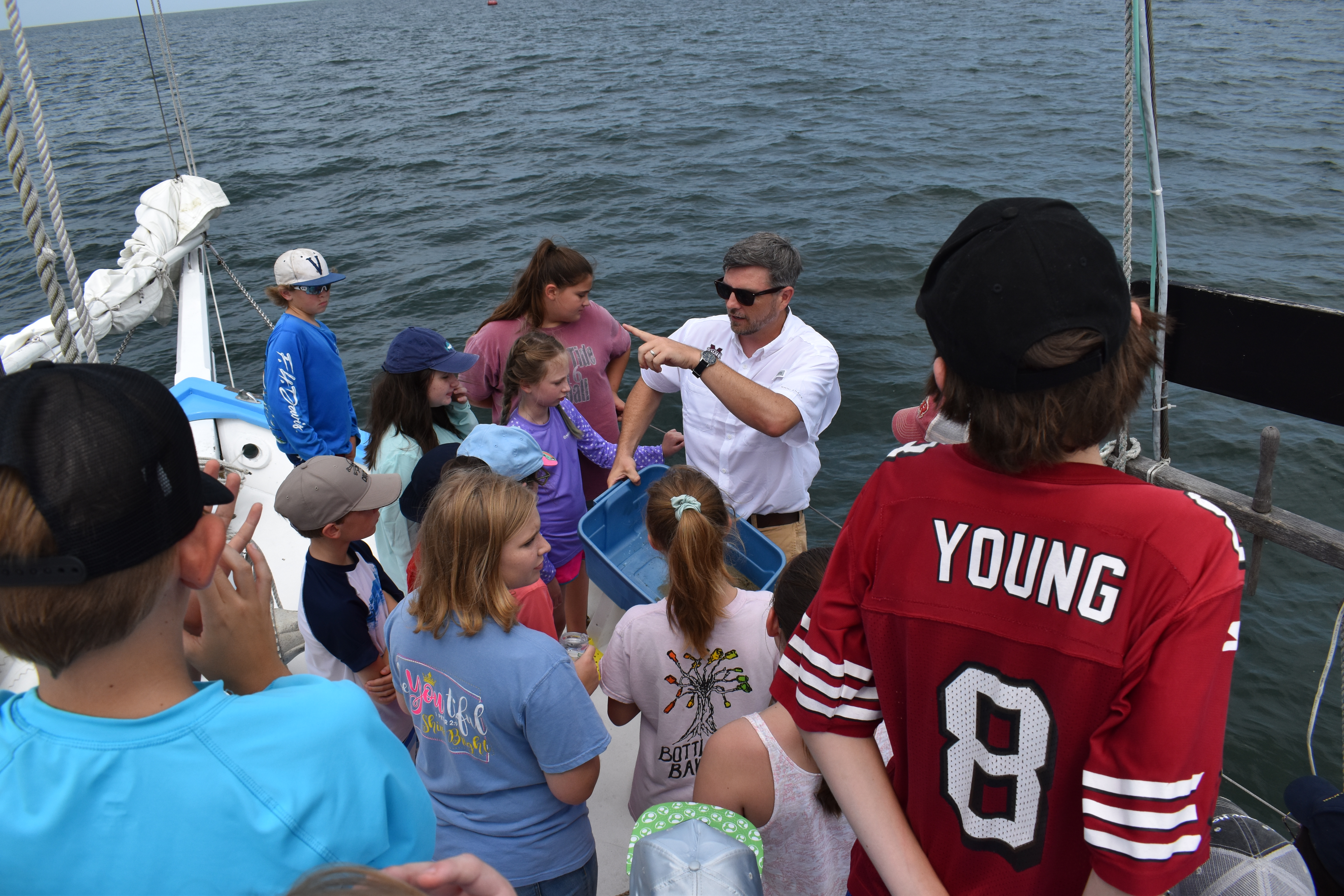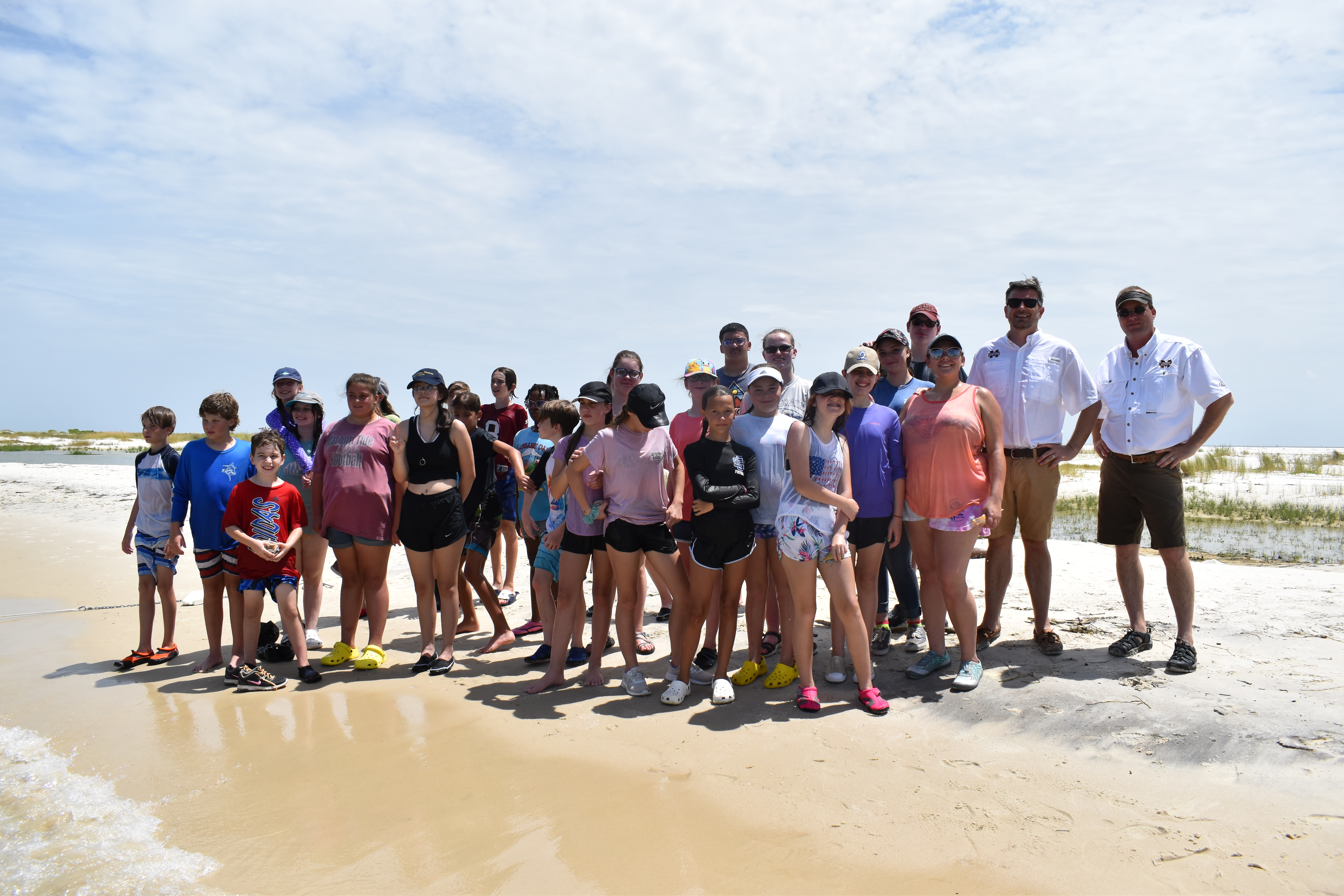NGI and the Mississippi Aquarium Partner, Launch First MSU-SEAS Program
August 26, 2021

Students aboard the Biloxi Schooner, "Glenn L. Swetman," head to Horn Island for an MSU-SEAS educational marine excursion. Photo by Jonathan Harris
Twenty-seven students now have a deeper appreciation for protecting the Gulf of Mexico's marine ecosystem. This past weekend, faculty and staff from the Northern Gulf Institute, an NOAA cooperative institute at Mississippi State University, and the Mississippi Aquarium launched the first MSU-SEAS (Science and Education at Sea) Program by taking middle and high school students on a marine excursion aboard the "Glenn L. Swetman." Biloxi Schooner.
The sailing vessel set course for the National Park Service Barrier Islands and anchored at Horn Island to give the sixth through 12th-grade students a day to be totally immersed in marine science education. Hands-on activities included collecting marine scientific data, water quality samples, seafloor sediment, identification of various marine species, and invasive aquatic plants.
Through the MSU-SEAS program, NGI and the Mississippi Aquarium are turning the State's Gulf Coast into an outdoor laboratory to give students a heightened appreciation for the connection between them, marine life and the environment. The hope is that the hands-on experience will lead to positive behavioral practices that promote sustainable choices in the future by teaching the students the importance of respecting the Gulf of Mexico's ecosystem.
NGI's Director of Outreach, Jonathan Harris said, "We believe an engaged and informed public is a great partner in the effort to protect the Gulf of Mexico's environment. By giving students access to this kind of learning, NGI and the Mississippi Aquarium will make its research relevant to the students who will become the stakeholders and citizens of the future."

Students of the MSU-SEAS Program Sketching from their observations on the offshore excursion. The NGI mission often includes the Artistic component to STEAM Learning.
(Science, Technology, Engineering, ARTS, and Mathematics).

Dr. Adam Skarke discusses marine sediment and the origins of the barrier islands in the Mississippi Sound. Photo by Jonathan Harris

Dr. Jamie Dyer discusses land breeze vs sea breeze and how you can make observations from the clouds to interpret those conditions.
Photo by Jonathan Harris.
Another program priority is to engage the students in the learning process. The program's education experts said one of the main tenets of modern educational theory is the concept of experiential learning, which is an engaged learning process where students learn by doing. This excursion gave students from across the Gulf Coast the opportunity to experience firsthand the excitement of learning by doing.
Adam Skarke, an NGI researcher and an MSU faculty member, introduced the students to the many components of marine hydrogeology. The former scientist with the NOAA Office of Exploration and Research said, "The idea was that through exposure to real-life scientific sampling techniques and locally relevant lesson content, we could remove the shadow of classroom learning and spark an interest in the sciences that will impact not only their future educational choices but also their life-long interest and hopefully their career pathways."
MSU faculty and team members also serving as excursion teachers included Jamie Dyer, an associate NGI director and Gray Turnage, an invasive aquatic species researcher, as well as Lauren Fuller and Lizzie Whigham from the Mississippi Aquarium.
The four marine experts agreed and offered, "Many of the students in our region, don't have the opportunity to experience science firsthand, especially at sea. While reading about scientific study in a classroom may provide a basis for understanding, actively undertaking sampling and physically interacting with the world around them is extremely beneficial to students from both a societal and educational standpoint."
NGI and the Mississippi Aquarium plan to offer the MSU-SEAS program to public and home-school students twice a year. The goal is to expose them to opportunities that may well guide them in shaping their dreams to benefit the very environment in which they live.
The Northern Gulf Institute, a National Oceanic and Atmospheric Administration (NOAA) Cooperative Institute managed by Mississippi State University, is a partnership of six complementary academic institutions and NOAA addressing important national strategic research and education goals. For more information, please visit
www.ngi.msstate.edu.
The Mississippi Aquarium, a premier institution, delivers an awe-inspiring entertainment experience that supports animal research and conservation, inspires learning and instills a passion for the aquatic world. For more information, please visit
www.msaquarium.org
For more information about the MSU-SEAS Program, please contact NGI Outreach Director, Jonathan Harris at
jharris@ngi.msstate.edu.
By
Diane L. Godwin

Lauren Fuller of the Mississippi Aquarium discusses the habitat and ecology of the Bottle Nosed Dolphin in Mississippi Sound.
Photo by Jonathan Harris.

The students of the inaugural MSU-SEAS Program on Horn Island in the National Park Service's Gulf Islands National Seashore in Mississippi Sound. Photo by Jonathan Harris.





